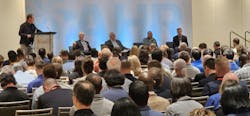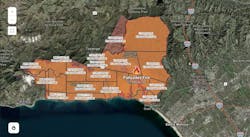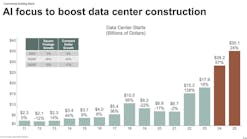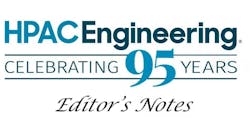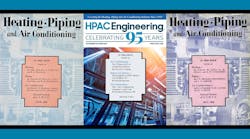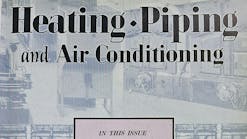In keeping with tradition and in preparation for the new year, we asked members of the HPAC Engineering Editorial Advisory Board and recent guests on our HPAC On The Air podcast for their views on what they expect to see from our industry in 2025.
What follows are their edited responses...
William P. Bahnfleth, PhD, PE, FASHRAE
ASHRAE past president; former chair, ASHRAE Epidemic Task Force; Professor of Architectural Engineering, Penn State University
Although there is much uncertainty in the world as 2025 begins, I think positive developments are possible. The two key questions for the HVACR community are whether energy conservation and decarbonization efforts will continue to move forward aggressively and whether the heightened interest in indoor air quality that have been driven by the Covid pandemic and wildfire smoke incidents will lead to significant change.
We have already seen in recent years that industry-led and individual efforts related to energy and carbon emissions have been fairly resilient to shifting political winds. I believe that the same is possible for IAQ now, based on the level of public interest and the number of active state and municipal initiatives, not to mention several bills being considered by the federal legislature in the US that are intended to raise the bar for IAQ.
So I am optimistic that some of these efforts will be successful during the coming year, with or without federal support. As is often the case, our determination to reach our goals is likely to be the key factor.
######
Jim Pauley, President and CEO
National Fire Protection Association (NFPA)
The devastating wildfires in Southern California are a stark reminder that fire safety must remain a priority in the face of growing risks. From disasters to advancing technologies, our world faces increasingly complex challenges, making it more critical than ever to uphold rigorous safety standards.
Unfortunately, efforts to bypass time-tested fire codes and standards are threatening the safeguards that protect lives and property. When safety measures are compromised—whether by neglect, cost-cutting, or insufficient oversight—the consequences are tragic.
At NFPA, we advocate for a collective commitment to safety through the NFPA Fire and Life Safety Ecosystem™. By fostering collaboration between fire safety professionals, lawmakers, and communities, we can ensure that lessons from past tragedies guide us toward a safer future.
Safety comes at a cost, but the cost of inaction is far greater. Together, we must defend and prioritize safety, protecting people and property in 2025 and beyond.
######
Ginger Scoggins, PE, LEED AP, FASHRAE
ASHRAE immediate past president; Founder, Engineered Designs Inc.
I expect to see more companies focused on lowering their carbon footprint in 2025. The year 2030 is rapidly approaching, and if companies don’t start working on their impact to the environment this year, they might have issues hitting their goals for lower carbon emissions. So I would think that consulting firms like mine will be receiving more requests for carbon calculating efforts as well as energy modeling efforts.
We have to reduce the impact of the built environment on global greenhouse carbon emissions. To do so, we have a very large job ahead of us and we must get moving on it. Not just in large cities, but in medium-size cities and rural areas, as well. To date, the larger cities have been leading this charge, but this effort needs to trickle down to smaller firms and areas so that we are all working toward the same goal of reducing the impact of our buildings on our environment.
#####
Charles E. Gulledge III, PE, LEED AP, FASHRAE
ASHRAE past president; Director of Engineering, Environmental Air Systems LLC
Regarding commercial refrigeration, the biggest impact is the refrigerant phasedown happening across the country, and more specifically for 2025 in California. As of January 1, 2025, California CARB regulations will ban the sale and distribution of “virgin” refrigerants with a global warming potential (GWP) greater than 2,200.
This ban will affect refrigerants still commonly used in many legacy supermarkets, namely R-404A and R-507. Supermarkets are allowed to continue to use R-404a and R-507 in their existing refrigeration systems. The catch being, only reclaimed refrigerant is allowed to replace leaked refrigerant, of which legacy (older) supermarkets leak 20% - 25% of their refrigerant annually.
So we have the proverbial rock and a hard place. People need food and food needs refrigeration for safe distribution to the public. It is worth noting that many of the legacy stores are in either urban or rural areas where the feasibility is low to replace a legacy refrigeration system with one from the modern age. The economic cost, space and infrastructure of the older supermarkets, and availability of skilled installation and maintenance technicians, make it very difficult to change from R-404a to a modern refrigerant. So, what will stores do when they can’t obtain the refrigerant they need?
#####
Nancy Kohout, PE, LEED AP
Senior Principal / Mechanical Discipline Leader, SmithGroup
I hope the industry realizes the shortage in talent we are facing and focuses on workforce development more in 2025. There is high demand specifically for skilled technicians which will require enhanced training programs and initiatives to attract new human capital to the industry.
On the technology front, I expect 2025 to continue the transition towards low GWP refrigerants to meet environmental regulations and sustainability goals. This will also require the need to develop advanced leak detection systems and train technicians on how to handle these refrigerants safely.
The same can be said for my business, one of the first South Florida-based engineering firms with its practice limited to commercial energy and sustainability consulting. Now in its 15th year, it has experienced consistent growth through a major recession, the Covid epidemic, and several sustained periods of economic uncertainty. Personally, I don’t anticipate that to change, since most of what we do – green building certifications, energy audits, and high-performance building commissioning – is voluntary or locally required, not federally mandated.
#####
Elizabeth Beardsley, Senior Policy Counsel, U.S. Green Building Council
With extreme weather and increased impacts from storms and other disasters, we see governments, insurance, and the building industry investing more in resilience. These risks and losses are affecting all states and don’t care about political party. Businesses and residents want to be secure and safe, and we see state and local governments increasingly adopting policies and programs to facilitate and incentivize resilient buildings. The proliferation of data centers and their energy use are also garnering attention from jurisdictions. USGBC is engaging to create positive policy opportunities.
Corporations have been an important driver for sustainable and low carbon buildings. While anti-ESG rhetoric and activities seem to be having some chilling effect, building portfolio decarbonization through efficiency, electrification, and use of renewable energy still makes financial business sense for many companies and we see these activities continuing, perhaps with less fanfare. Moreover, large and global companies that fall under corporate climate reporting laws, like the EU Corporate Sustainability Reporting Directive (CSRD) or California’s climate disclosure laws, will be motivated to accelerate their efforts to reduce emissions. Moreover, we expect efforts to collaborate up and down supply chains for building construction and operations will expand.
We take a long view in our policy work. We expect 2025 to perhaps feel like a roller coaster at times, at least in the U.S. national headlines, but the steady work to improve the resilience and efficiency of our buildings will continue in both the private and public sectors.
#####

